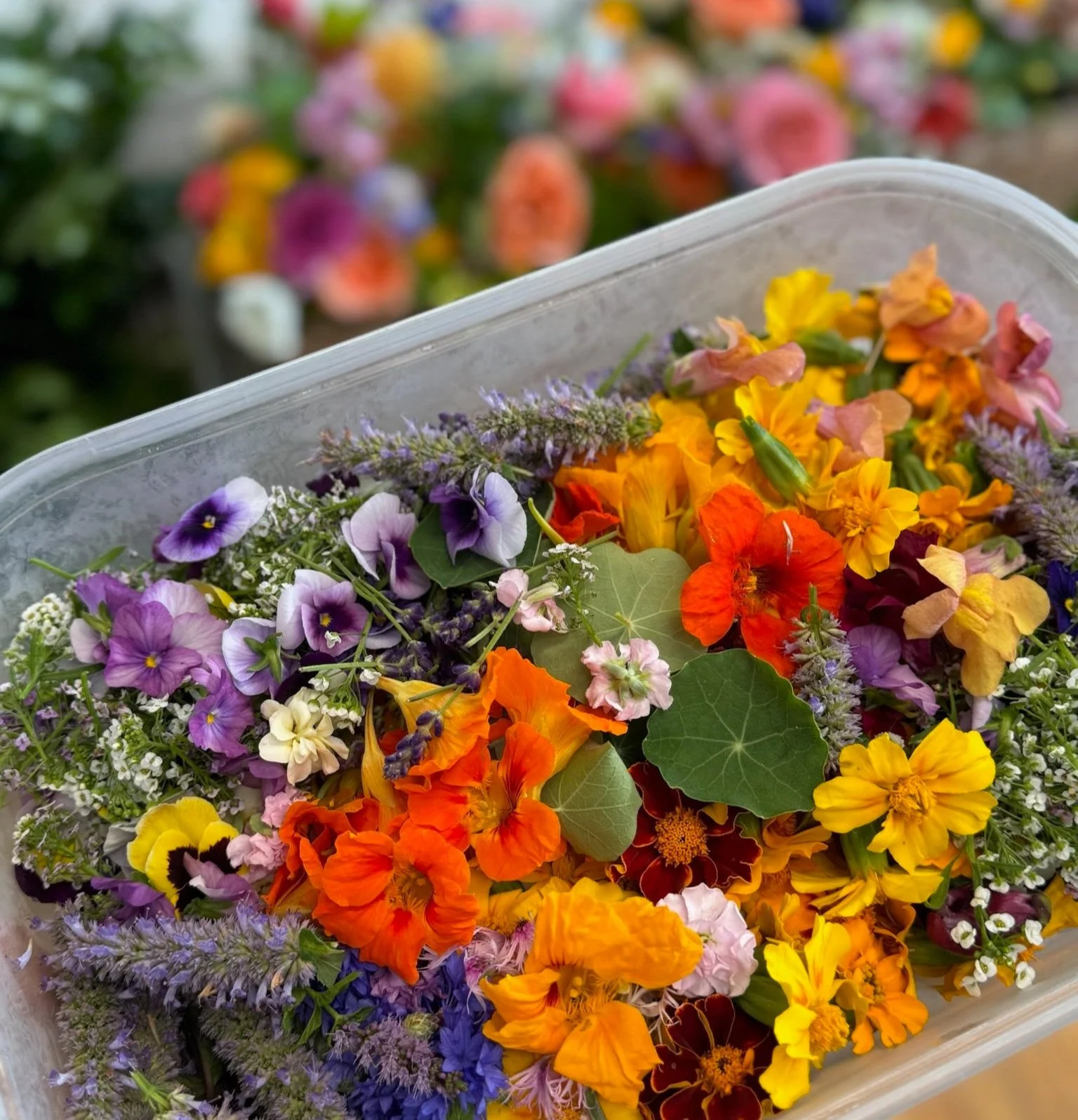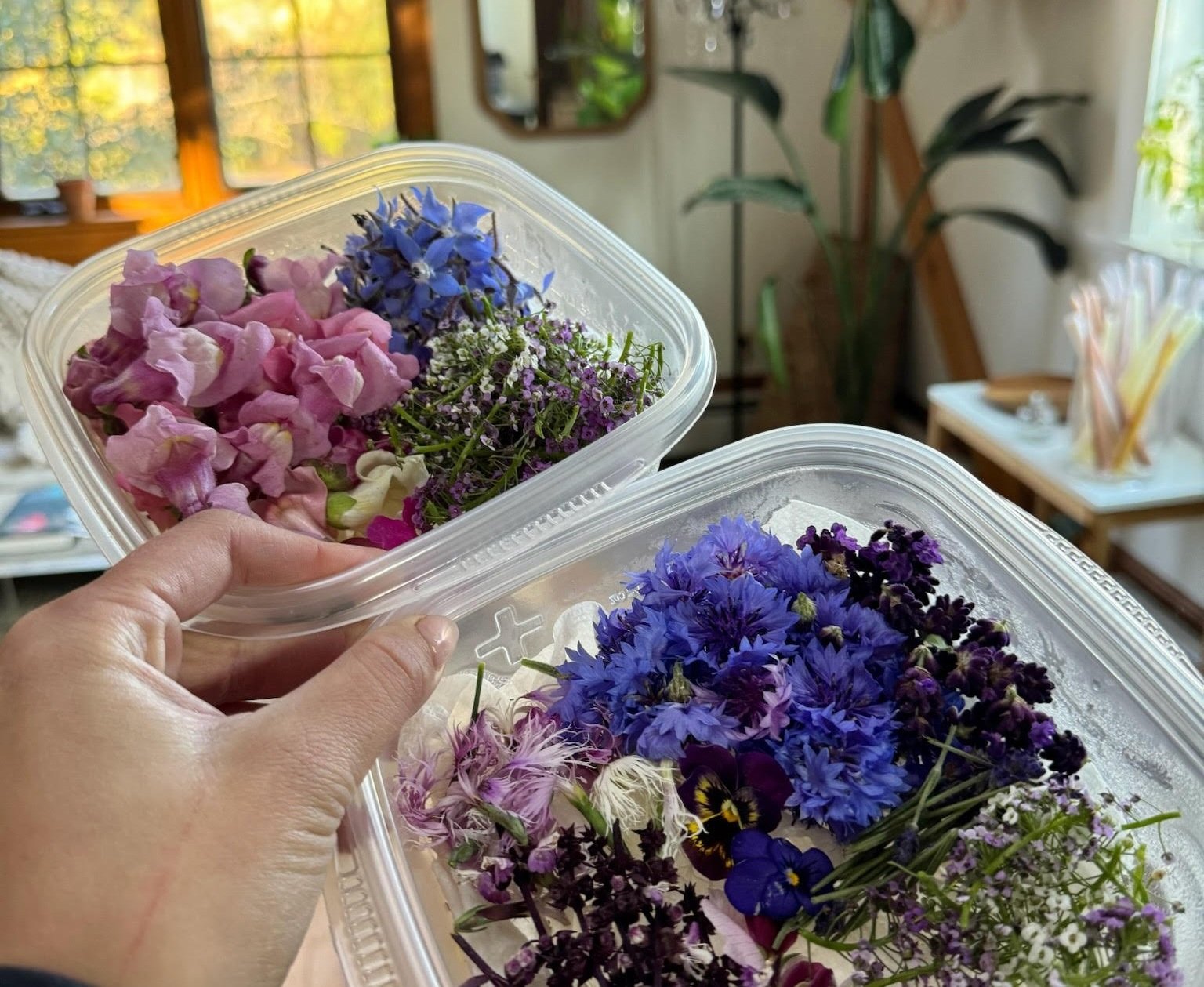13 Edible Flowers To Try This Year
Carolyn Pavlik, edible flower expert and owner of Spring Break Flower Farm, shares the flavor profiles of thirteen flowers you can eat
@springbreakflowerfarmpa ~ Located in Gilbertsville, PA
Written by Carolyn Pavlik
My journey through the flower world, and especially edible flowers, was one of happenstance. I started working on farms during college and after college I tried the corporate world for a bit but found myself still yearning for the farm. In my early twenties I answered an ad for a farm worker position thinking it would be your usual planting, weeding etc, until I got there and one of the employees asked, “Do you have any interest in edible flowers?” I said “Possibly!” with really zero idea what that meant or what that entailed. I was just out of college and my diet mainly consisted of veggie burgers and diet coke - I never once considered cooking with a flower you can eat. This rocketed me into a whole new world. The farm I worked for had just lost their flower farmer and needed a replacement to keep up with demand. They were in attendance at the Union Square Greenmarket in Manhattan and had lots of restaurant, bakery and caterer accounts to keep up with. Soon after, I spent almost every day either shadowing the other employees learning how to care for and pick a plethora of edible flowers and then bringing them down into the city to sell them to the chefs and bakers who eagerly awaited them.
Some edible flowers, I learned, are incredibly sought-after in the culinary world. And now once I know and love them, I understand! A few of the most popular and traditional favorites include:
Nasturtiums: Crisp, feathery soft with an arugula like spiciness. These are definitely one of the tastiest in my opinion. Their lily pad leaves share the same taste and can be eaten too. Add them to a salad, layer them in a spring roll or eat them as is!
Pansies: Mild, grassy, subtly floral. Very mild, so their taste won't overpower your dish. These are great inside ice cubes for a cocktail, pressed into pasta dough for a twist on pasta night or to decorate bite size treats for a party. They hold up to candying and sprinkling with sugar as well.
Borage: Bright, light, cucumber taste with a fuzzy exterior. I like these added to fresh and chilled meals. Great with seafood, a slaw with a hint of acid or a cooled gazpacho.
Sugar Snap Pea Blossoms: Crunchy and sweet. Very delicate and can be paired with their curly tendrils for a whimsical look. Great for savory and sweet dishes alike. *Note this is the vegetable pea, not ornamental sweet peas ~ which are notably poisonous!
Chive Flowers: Onion, with a kick: Don’t forget about these purple blossoms after you’ve cut a handful of chives. They’re onion-like to the max. I like to break them apart and sprinkle them on top of a stir fry or decorate a loaf of garlic bread for a colorful kick.
Cornflower: Vegetal, mild, slightly sweet. I love these because they are resilient and stand up to drying while retaining their color. While “cornflower blue” is what they're known for, they come in assorted colors! Try folding them into a spreadable cheese or compound butter.
An edible flower order fulfilled by Carolyn Pavlik of Spring Break Flower Farm for a 2024 Waverly Flower Co. Event; The client, a luxury car company, specifically requested purple and blue flowers as drink garnishes for a Main Line gala.
These were some of the most common flowers I found myself getting order after order for and I see why! But there are many more that surprised me throughout the season.
7. Gem Marigolds: Citrusy, with peppery undertone. These are so durable and really mean summer to me. They can range from decorating cakes, to accompanying a protein based meal, to infusing your favorite cooking oil for summer all year long.
8. Lilacs: Floral, bitter. Every spring I wish I could keep their scent all year long. These are by far my favorite dessert flower. Steep them in a syrup for a floral pancake brunch or for a sparkling soda.
9. Snapdragons: Bland, bitter. Okay, flavor profile isn’t my favorite on these but they’re too pretty not too decorate with. They come in so many fascinating colors that they're great as a cupcake topper. You can also squeeze them which opens their “mouth” which makes them super cute to snap onto the rim of a bowl or cocktail glass.
10. Carnations: Subtle sweetness, light clove flavor. No longer the bouquet flower with a bad reputation. (Although personally I think that reputation is undeserved!). Larger sized flower great for charcuterie boards and cakes. Although I usually separate the petals from their sepal for fun and colorful flower confetti to sprinkle in a salad.
11. Abutilon: Light and sweet. This is my favorite statement flower! Member of the mallow family so they have a great tropical look. Great for larger cakes and desserts. Maybe dressing up a gorgeous pavlova or elevating a fresh fruit salad.
12. Stock: Nutmeg, slightly spicy. I love the texture of these cuties. Their flowers have a succulent-like texture. And since they love cool weather I find they pair perfect with spring produce like peas, baby lettuces and other tender greens.
13. Squash blossoms or “Flor de calabaza”. A light, floral, squashy taste. A culturally important edible flower to many. Most commonly harvested from zucchini plants but at my former employment Rooted Family Farm in the Hudson valley I was taught pumpkin flowers make the best squash blossoms in size and color. Try them layered in a quesadilla or stuffed with soft cheese, battered and fried. Or for a sweet version, stuff with ripe banana, batter, fry and drizzle with good maple syrup and cinnamon.
While these are just a small sampling of the many edible flowers used by chefs and gardeners all over the world, I love these choices for elevating my dishes effortlessly - They always brings the “wow” factor to a party! Have fun with your food and bring flowers to your plate at your next get together.
Of course, with any experimentation with edible flowers, please do your research. Many have poisonous doppelgangers and take verified research or a trusted farmer to confirm. Another important note about edible flowers is always buy from a trusted source and never from a traditional florist. Most conventional flowers are treated with pesticides and other sprays not used for human consumption.


